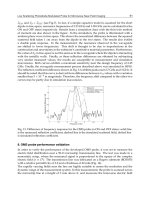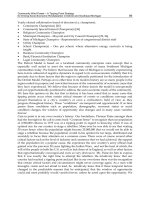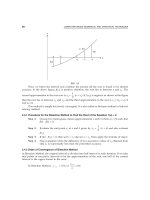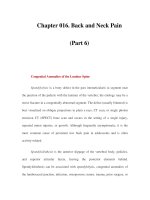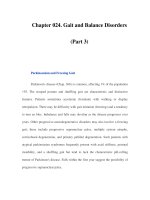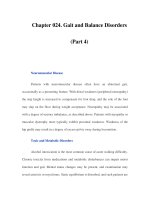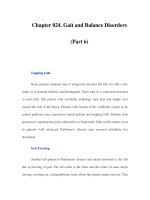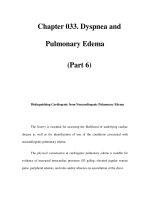Chapter 072. Malnutrition and Nutritional Assessment (Part 6) pptx
Bạn đang xem bản rút gọn của tài liệu. Xem và tải ngay bản đầy đủ của tài liệu tại đây (57.41 KB, 12 trang )
Chapter 072. Malnutrition and
Nutritional Assessment
(Part 6)
Anthropometrics
Anthropometric measurements provide information on body muscle mass
and fat reserves. The most practical and commonly used measurements are body
weight, height, triceps skinfold (TSF), and mid-arm muscle circumference
(MAMC). Body weight is one of the most useful nutritional parameters to follow
in patients who are acutely or chronically ill. Unintentional weight loss during
illness often reflects loss of lean body mass (muscle and organ tissue), especially if
it is rapid and not caused by diuresis. This can be an ominous sign since it
indicates use of vital body protein stores as a metabolic fuel. The reference
standard for normal body weight, body mass index (BMI, or weight in kilograms
divided by height, in meters, squared), is discussed in Chap 75. BMIs <18.5 are
considered underweight, 18.5–24.9 are normal, 25–29.9 are overweight, and ≥30
are obese.
Measurement of skinfold thickness is useful for estimating body fat stores,
because about 50% of body fat is normally located in the subcutaneous region.
Skinfold thicknesses can also permit discrimination of fat mass from muscle mass.
The TSF is a convenient site that is generally representative of the body's overall
fat level. A thickness of <3 mm suggests virtually complete exhaustion of fat
stores. The MAMC, often used to estimate skeletal muscle mass, is calculated as
follows:
Laboratory Studies
A number of laboratory tests used routinely in clinical medicine can yield
valuable information about a patient's nutritional status if a slightly different
approach to their interpretation is used. For example, abnormally low serum
albumin levels, total iron-binding capacity, and anergy may have a distinct
explanation, but collectively they may represent kwashiorkor. In the clinical
setting of a hypermetabolic, acutely ill patient who is edematous and has easily
pluckable hair and inadequate protein intake, the diagnosis of kwashiorkor is
clear-cut. Commonly used laboratory tests for assessing nutritional status are
outlined in Table 72-5. The table also provides tips to help avoid assigning
nutritional significance to tests that may be abnormal for nonnutritional reasons.
Table 72-5 Laboratory Tests for Nutritional Assessment
Test
(Normal Values)
Nutritional
Use
Causes of
Normal Value
Despite
Malnutrition
Other Causes
of Abnormal Value
2.8–3.5:
Compromised
protein status
Dehydratio
n
Low
<2.8:
Possible
kwashiorkor
Infusion of
albumin, fresh
frozen plasma, o
r
whole blood
Common:
Serum
albumin(3.5–5.5
g/dL)
Increasing
value reflects
positive protein
Infection and
other stress, especially
with poor protein
balance intake
Burns, trauma
Congestive
heart failure
Fluid
overload
Severe liver
disease
Uncommon:
Nephrotic
syndrome
Zinc
deficiency
Bacterial
stasis/overgrowth of
small intestine
10–15
mg/dL: Mild
protein depletion
Chronic
renal failure
Similar to
serum albumin
5–
10 mg/dL:
Moderate protein
depletion
<5 mg/dL:
Severe protein
depletion
Serum
prealbumin, also
called transthyretin
(20–
40 mg/dL;
lower in
prepubertal
children)
Increasing
value reflects
positive protein
balance
<200:
Compromised
prote
in status,
possible
kwashiorkor
Iron
deficiency
Low
Increasing
value reflects
positive protein
balance
Similar to
serum albumin
More labile
than albumin
High
Serum total
iron binding
capacity (TIBC)
240–450 µg/dL
Iron deficiency
Prothrombi
n time 12.0–
15.5
sec
Prolongation
: vitamin K
deficiency
Prolonged
Anticoagulant
therapy (warfarin)
Severe liver
disease
<0.6: Muscle
wasting due to
prolonged energy
deficit
High
Reflects
muscle mass
Despite muscle
wasting:
Renal failure
Serum
creatinine 0.6–
1.6
mg/dL
Severe
dehydration
24-
h urinary
creatinine 500–
Low value:
muscle wasting due
>24-h Low
collection
to prolonged energy
deficit
Decreasing
serum creatinine
Incomplete
urine collection
Increasing
serum creatinine
1200 mg/d
(standardized for
height and sex)
Neuromuscular
wasting
24-
h urinary
urea nitrogen
(UUN) <5 g/d
(depends on level
of protein intake)
Determine
level of catabolism
(as long as protein
intake is
≥10 g
below calculated
protein loss or <20
g total, but at least
100 g carbohydrate
is provided)
5–
10 g/d =
mild catabolism or
normal fed state
10–
15 g/d =
moderate
catabolism
>15 g/d =
severe catabolism
Estimate
protein balance
Protein
balance = protein
intake –
protein loss
where protein loss
(protein catabolic
rate) = [24-
h UUN
(g) + 4] x 6.25
Adjustments
required in burn
patients and others
with large
nonurinary nitrogen
losses and in
patients with
fluctuating BUN
levels (e.g., renal
failure)
<8: Possibly
inadequ
ate protein
intake
Low
Blood urea
nitrogen (BUN) 8–
23 mg/dL
12–23:
Possibly adequate
protein intake
Severe liver
disease
>23:
Possibly excessive
protein intake
Anabolic state
If serum
creatinine is normal,
use BUN
Syndrome of
inappropriate
antidiuretic hormone
If serum
creatin
ine is
elevated, use
BUN/creatinine
ratio (normal range
is essentially the
same as for BUN)
High
Despite poor
protein intake:
Renal failure
(use BUN/creatinine
ratio)
Congestive
heart failure
Gastrointestina
l hemorrhage
